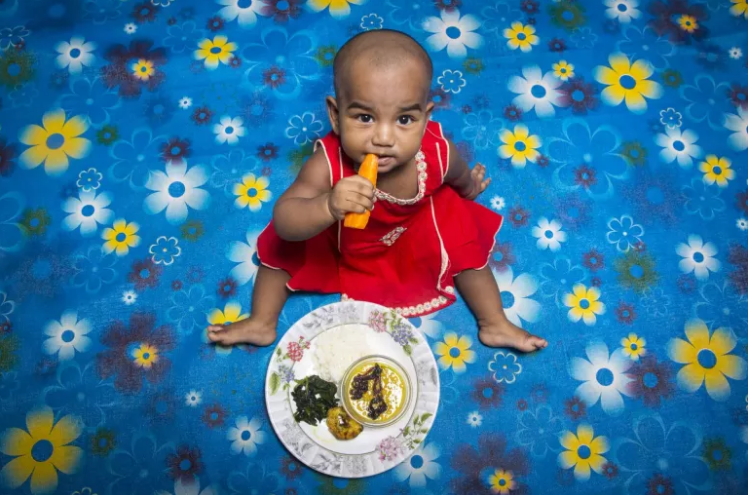Children experiencing this level of food poverty are up to 50 percent more likely to suffer from life-threatening malnutrition, the new analysis finds
NEW YORK, 6 June 2024 – Around 181 million children worldwide under 5 years of age – or 1 in 4 – are experiencing severe child food poverty, making them up to 50 percent more likely to experience wasting, a life-threatening form of malnutrition, a new UNICEF report reveals today.
For the first time, Child Food Poverty: Nutrition Deprivation in Early Childhood analyses the impacts and causes of dietary deprivation among the world’s youngest people in nearly 100 countries, and across income groups. It warns that millions of children under the age of five are unable to access and consume a nutritious and diverse diet to sustain optimal growth and development in early childhood and beyond.
Children who consume, at most, two of eight defined food groups are considered to be in severe child food poverty. Four out of five children in this situation are fed only breastmilk/milk and/or a starchy staple, such as rice, maize, or wheat. Less than 10 percent of these children are fed fruits and vegetables. And less than 5 percent are fed nutrient-dense foods such as eggs, fish, poultry, or meat.
“Children living in severe food poverty are children living on the brink. Right now, that is the reality for millions of young children, and this can have an irreversible negative impact on their survival, growth, and brain development,” said UNICEF Executive Director Catherine Russell. “Children who consume just two food groups per day, for example, rice and some milk, are up to 50 percent more likely to experience severe forms of malnutrition.”
The report warns that while countries are still recovering from the socio-economic impacts of the COVID-19 pandemic, the effects of growing inequities, conflicts, and the climate crisis have pushed food prices and the cost of living to record high levels.
Of the 181 million children living in severe food poverty, 65 percent reside in just 20 countries. Around 64 million affected children are in South Asia, and 59 million are in Sub-Saharan Africa.
In Somalia, a country experiencing conflict, drought, and floods, 63 percent of children are living in severe child food poverty, and in the most vulnerable communities, over 80 percent of caregivers reported that their child had been unable to eat for an entire day.
In the Gaza Strip, months of hostilities and restrictions on humanitarian aid have collapsed the food and health systems, resulting in catastrophic consequences for children and their families. Five rounds of data collected between December 2023 and April 2024 have consistently found that 9 out of 10 children in the Gaza Strip are experiencing severe food poverty, surviving on two or fewer food groups per day. This is evidence of the horrific impact the conflict and restrictions are having on families’ ability to meet children’s food needs – and the speed at which it places children at risk of life-threatening malnutrition.
The report finds nearly half (46 percent) of all cases of severe child food poverty are among poor households where income poverty is likely to be a major driver, while 54 percent – or 97 million children – live in relatively wealthier households, among whom poor food environments and feeding practices are the main drivers of food poverty in early childhood.
Several factors are fueling the child food poverty crisis, including food systems that fail to provide children with nutritious, safe, and accessible options, families’ inability to afford nutritious foods, and parents’ inability to adopt and sustain positive child-feeding practices. In many contexts, cheap, nutrient-poor, and unhealthy ultra-processed foods and sugar-sweetened beverages are aggressively marketed to parents and families and are the new normal for feeding children. These unhealthy foods and beverages are consumed by an alarming proportion of young children experiencing food poverty, displacing more nutritious and healthier foods from their daily diets.
At the same time, there have been notable successes. For example, Burkina Faso has halved the rate of severe child food poverty from 67 percent (2010) to 32 percent (2021). Nepal has reduced the severe child food poverty rate from 20 percent (2011) to 8 percent (2022). Peru has kept the rate below 5 percent since 2014 amid a prolonged period of economic decline, and Rwanda has cut the rate from 20 percent (2010) to 12 percent (2020).
To end child food poverty, UNICEF calls on governments, development and humanitarian organizations, donors, civil society and the food and beverage industry to urgently:
- Transform food systems so that nutritious, diverse, and healthy foods are the most accessible, affordable, and desirable option for caregivers to feed young children.
- Leverage health systems to deliver essential nutrition services to prevent and treat malnutrition in early childhood, including support for community health and nutrition workers to counsel parents and families on child feeding and care practices.
- Activate social protection systems to address income poverty through social transfers (cash, food, and vouchers), in ways that are responsive to the food and nutrition needs of vulnerable children and their families.
To accelerate actions to prevent, detect, and treat severe child food poverty and malnutrition, the Child Nutrition Fund (CNF) was launched last year by UNICEF, with the support of the UK Foreign Commonwealth and Development Office (FCDO), the Bill and Melinda Gates Foundation, and the Children’s Investment Fund Foundation (CIFF). The CNF is a UNICEF-led multi-partner financing mechanism that incentivizes domestic investments to end child malnutrition. UNICEF urges governments, donors, and financial partners to support the CNF and prioritize sustainable policies and practices to end severe child food poverty and malnutrition.
Credit: UNICEF

